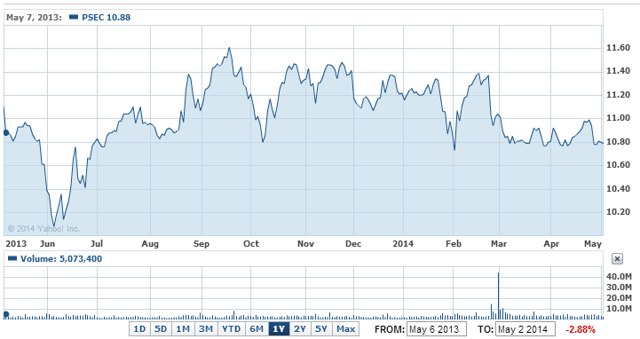Summary
- Volatility in BDCs likely to be short-lived.
- Prospect’s fundamentals and ability to generate elevated income still look favorable.
- Progress in company’s Harbortouch deal will be telling in terms of what to expect next in earnings.
Earlier this year, Russell and Standard & Poor’s both announced decisions to cut business development companies (BDCs), and a wave of panic selling was later seen in several of the sector’s biggest names. In the time since, Ares Capital (NASDAQ:ARCC), Market Vectors BDC Income ETF (NYSEARCA:BIZD), and Prospect Capital (NASDAQ:PSEC) have all met with downside pressure and are trading near their lows for the year. But the decisions at Russell and S&P have done nothing to change the fundamental outlook for these names and the declining stock valuations should be looked at as a solid opportunity to start building exposure in a critical market sector.
BDCs offer much needed financing for many small and mid-sized companies that might be flying under the radar of most banks. Previously, BDCs were allowed into the major stock benchmarks because they offer opportunities for investors to gain access to companies that are not publicly traded. Concerns over expenses and reporting requirements were a big part of the rationale behind the recent decision to start excluding BDCs. But the reality is that many of the apparent expenses come from the corporate structure that is associated with BDCs. These acquired fees are not actually paid by investors, so there is little reason for investors to share these concerns.
Volatility in BDCs Will be Short-Lived
In other words, the knee-jerk volatility that was created by the announcements from S&P and Russell should be short-lived. If anything, the negative moves in market valuations should be viewed as an opportunity rather than as a reason to run to the exits. The stock benchmarks will be updated in June and, at this stage, it looks like most of the selling is already behind us. BDCs like Prospect Capital still have several advantages supporting the outlook, and this has been matched by a series of analyst upgrades in recent months. Deutsche Bank, Wunderlich Securities, and Guggenheim have all upgraded the stock to a “buy” rating with price targets at or above $12.
This is some attractive potential upside, especially given the fact that most investors actually prize the stock for its consistent ability to generate massive levels of income. To some, PSEC’s elevated dividend yield of 12.3% might seem unsafe and vulnerable to reductions down the line. But while this is always a possibility, Prospect Capital’s highly diversified asset base provides a strong layer of security for investors looking to gain long-term exposure. Prospect already offers exposure to more than 125 different companies, and closed $1.3 billion in loan originations in Q1 of this year. Further strength has already been seen this quarter, and it looks relatively clear that 2014 will be a record year for the company. Progress in loan originations give Prospect a solid outlet in generating fee income and recent efforts to raise cash support the outlook for improved loan activity in the second quarter.
What to Watch For Next
On May 6, Prospect will report earnings and all eyes will be focusing on the company’s ability to build on what it achieved in the record-setting performance seen in Q1. Key points to watch lie in Prospect’s ability to capitalize on its arrangements with Harbortouch in creating new channels for high interest loans to business owners. Prospect’s investment in Harbortouch is valued at nearly $280 million, and evidence of progress here could strengthen the outlook for what most will expect from the company over the next few quarters.
PSEC: Chart Perspective
(Chart Source: Yahoo! Finance)
The sell-off that started in February has started to stabilize in the 10.80 region, and this support area looks set to contain prices going forward, given the fact that it already marked a double bottom going back to last October. Resistance overhead is not seen until the 11.40 mark, so risk to reward ratios favor the upside.


